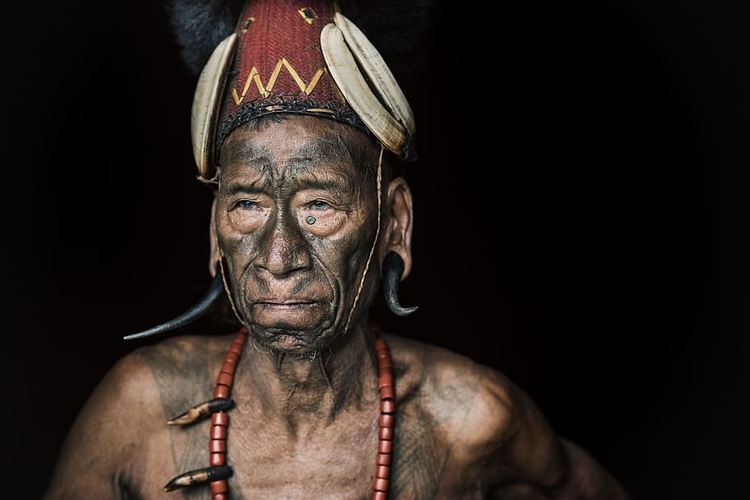For smooth Ad free experience
For smooth Ad free experience
Until the 1960s, the Konyaks of Nagaland was one of India's last tribes that practised headhunting. Earlier disputes over land, water and sometimes women, between competing clans and villages were resolved through fighting, and Konyaks were feared for their headhunting prowess. Today, though, headhunting is nearly unheard of, the most recent outbreak was in 1990.

Story of Konyak Nagas
The Konyaks are the largest tribe of the 17 officially recognized tribes of Nagaland. The term 'Konyak' is derived from the words 'Whao', which means 'head,' and 'Nyak,' which means 'black,' which translates to 'men with black hair.' They are divided into two groups: 'Thendu,' which means 'Tattooed Face,' and 'Thentho,' which means 'White Face.' The Thendu group is largely found in Nagaland’s Mon district central region, commonly known as 'The Land of The Anghs. ' Their traditional chiefs, the Anghs/Wangs, are held in high regard.
Tattooing and headhunting were intimately interwoven rituals of the Konyaks. After each raid, a warrior was adorned with aubergine-coloured diamond or lozenge markings on his body. He would get tattoos on his face, neck, and other parts of the body.
The inking tradition was done with the aid of a handcrafted comb. These tattooing combs were created with plant fibres and needles manufactured from rattan palm spikes. A Konyak's body would be transformed into a human canvas, on which intricate designs would be painstakingly hand-tapped with ink derived from Toona ciliata tree resin (commonly known as red cedar). The inking of a tribe member was a joyous occasion. It used to be celebrated by slaughtering a pig or a cow. Rice beer would be lavishly poured alongside traditional sticky red rice.
Phejin Konyak on her book “Konyaks: The Last of The Tattooed Headhunters” writes how different tattoos worn by persons conveyed his/her status, position, stage of life and achievements in Konyak society. The tattoos symbolized the men's transition from youth to manhood, as well as their victories in combat. For the woman, it marked her life cycle as she moved from one stage to the next. The women's tattoos were largely on their legs and arms, and the designs were simpler than the men's. Girls got tattoos at the age of 8-10, while boys got tattoos around the age of 13-15.
The different tattoos were idiosyncratic designs for those belonging to the aristocratic class, warriors, and married and unmarried women. Women were the ones who were proficient at tattooing.
According to traditions of headhunting, the heads were beheaded and displayed as trophies in a community barn known as a "baan." The number of heads beheaded was directly proportional to the warrior's dignity and social standing. Head-hunting expeditions were predicated on old honour standards, loyalty ideals, and particular beliefs about the sacrifices that had to be made. The tribe had a rigid code of conduct that everyone had to follow. They were expected to carry out their assigned duties and complete their responsibilities.
However, during British colonialism, this began to change. Missionaries began establishing schools and spreading Christianity across the country. Many Naga tribes converted to Christianity in exchange for free education, food, and shelter.
Headhunting was banned by the Indian government in 1960s, but Konyaks claim the ritual persisted for a few more years. Traditional Konyak attire includes bright tribal beaded jewellery, unique accessories, and elaborately woven shawls.
Earlier enemy skulls were proudly exhibited in the doors of Konyak homes. Since the practice was forbidden, they've been buried in mass graves. However, some of the skulls resurface during festivals. The Konyak tribe has passed down the abilities of handling the daw, or long-handled knife, down the years. Every man Konyak tribe member carries a pistol and a daw.
Gunsmithing, iron smelting, brass-working, and gunpowder-making are some of the Konyaks' other unique traditional techniques. They are also skilled in the creation of janglaü (machetes) and wooden sculptures.
The former warriors, who are usually in their 80s, may be identified by their massive ear piercings made of animal horns and war caps constructed of hunted wild pigs' horns, hornbill feathers, and wild bear or goat hair. They still have the knives they used to murder. The last of the headhunting warriors will be gone in another decade or so, but the Konyaks claim that the tribe's warrior past will carry on through oral tradition and festivals.
0
You might be interested in reading more from
